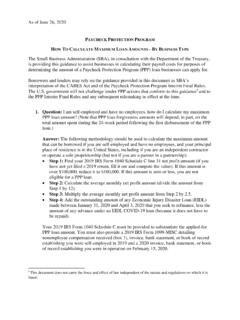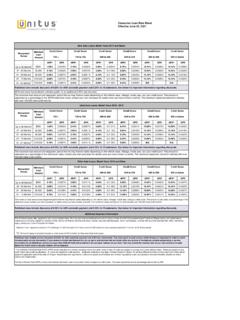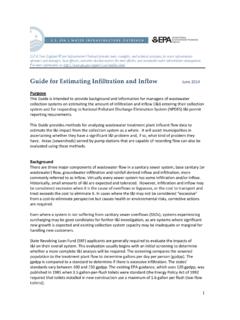Transcription of Taxable social security benefits worksheet 2020
1 Taxable social security benefits worksheet 2020 ContinueRetirement planning involves sacrificing part of what we earn today and investing that money in the hope that one day we will have enough assets from which we can raise income. But social security and Medicare systems work differently, taking a portion of the earnings from today's workers to pay for the needs oftoday's retirees. Just how much do we pay in social security and Medicare taxes over a lifetime, compared to how much do we get in benefits ? The answer depends on several variables, including gender, earnings, household configuration, retirement age and our health.
2 But overall, we get far more benefits than we payinto the system, according to new figures published by the Urban nonpartisan think tank has released tables showing how much the average person gets in life benefits compared to how much he or she pays in taxes, assuming an average life expectancy and a 2 percent real interest rate (meaning 2 percentabove inflation). One of the study's authors, one of the study's authors, Eugene Steuerle, explains the assumptions used in the calculations. No matter how much you pay into the system, whether you earn the average salary for life ($43,100 in 2010 dollars), or if you are in a family with two incomes where one earns ahigh wage and the other earns an average wage, you will get back significantly more than you pay in.
3 Than the average employee, no wonder. Example: A male average worker who retired at age 65 in 2010 paid $345,000 in total social security and Medicare taxes, but will receive $417,000 in total lifetime benefits ($464,000 for a woman). Much more inequality in taxes compared to benefits occurs for couples. In the case of a household with only one employee, the taxes paid amounted to $345,000, but the benefits received by both parties would be $778,000 on both sides. For a two-earning couple, where one earned an averagewage and the other earned a low salary ($19,400), the tax payout was $500,000, but the benefits would be $800, who have retired in recent decades have seen far more returns for their tax returns.
4 But it is obvious that this situation is not sustainable. It's like putting all your credit card costs on, knowing wellyou don't have the funds to pay it back. social security can still be fixed, but is a much more serious problem. What we're trying to point out through these numbers is that relying on deficits and income tax revenue to make up the Medicare funding gap means reducing other things that the government is doing or leavinga heavy burden for future generations to pay, says Steuerle. We all have a responsibility to address our large future projected deficits, both in general and within our social security systems; we're not entitled to any reasonable calculations the cost of fixing them for the younger generation.
5 It really isn't fair to saddle youngpeople with these costs at the expense of economic growth, and the sooner our political leaders solve this problem, the better for everyone. But in an illogical move, management in December cut payroll taxes by 2 percent until can fritter from this found money or do something smart with it, like increasing ourpension plan contributions, at least by that amount. If our leaders do not behave responsibly, it obliges us to do so. social security comes from the government, so it may seem strange for Uncle Sam to put his hand up and claim some of your benefits back - in the form of taxes.
6 But it happens. Normally, if social Securityis your only income, your benefits are tax-free and you probably don't need to file a federal tax return. But there are times when the Internal Revenue Service may really want a portion of your social security , depending on your total income and marital status. Avoid tax surprises that can make you dip into your retirementsavings. How to find out if you should taxRetirees should receive a form of SSA-1099 from the social security Administration by the end of January or early February. The form will show your total benefits , including monthly survivor's and disability benefits , but no additional security income payments that are not taxed.
7 Ifyou collect other income in addition to social security , you can owe taxes on at least part of your government benefits . To quickly calculate your potential tax liabilities, add half of your social security benefits to all your other income. In this calculation, you must also take into account any tax-free interest that you haveearned, as well as income exemptions such as interest on savings bonds, employment benefits , or income earned excluding foreign dollars. If this amount exceeds the base amount for your filing status, some of your benefits will be taxed.
8 Figuring out your tax billBase amounts to clarify possible tax liabilities for benefitsare: $25,000 for one, head of family, or qualifying widow or widower with dependent child. $25,000 for married individuals filing separately and who do not live with their spouses at any time during the tax year. $32,000 for married couples filing together. $0 for married individuals who have lived together at any time duringthe tax year. Typically, up to half of your benefits will be taxed if you exceed the base amount. However, up to 85 per cent of your benefits may be subject to if you are a single filer and in total all your other income plus half of your annual social security payments exceed $34,000, or $44,000 if you are married and filetogether.
9 You will need to fill out a worksheet found in your Form 1040 or 1040A instruction book, or in your tax software package to find out exact amount. If you're doing research on all this before you start taking social security benefits , use our calculator to see you how much you're likely to get. Pay for a yearIf yourstate pension money is taxed, you can avoid calculated tax payments and minimize your tax bill next year by having federal income tax withheld from your benefits . Just fill out a W-4V form, a voluntary retention request, and file it with the social security Administration.
10 You can choose to have 7 percent, 10 percent, 15percent or 25 percent of the total benefit payout withheld. If you subsequently decide that you don't want your taxes withheld, you can file another W-4V to stop the withholding. Additional information on social security benefits taxation is available in irs Publication 915, social security and Railroad Equivalents. A summaryof social security benefits is usually calculated using an average index monthly earnings. This average is up to 35 years of indexed employee earnings. We apply the formula to this average for calculating the primary insurance amount (PIA).














